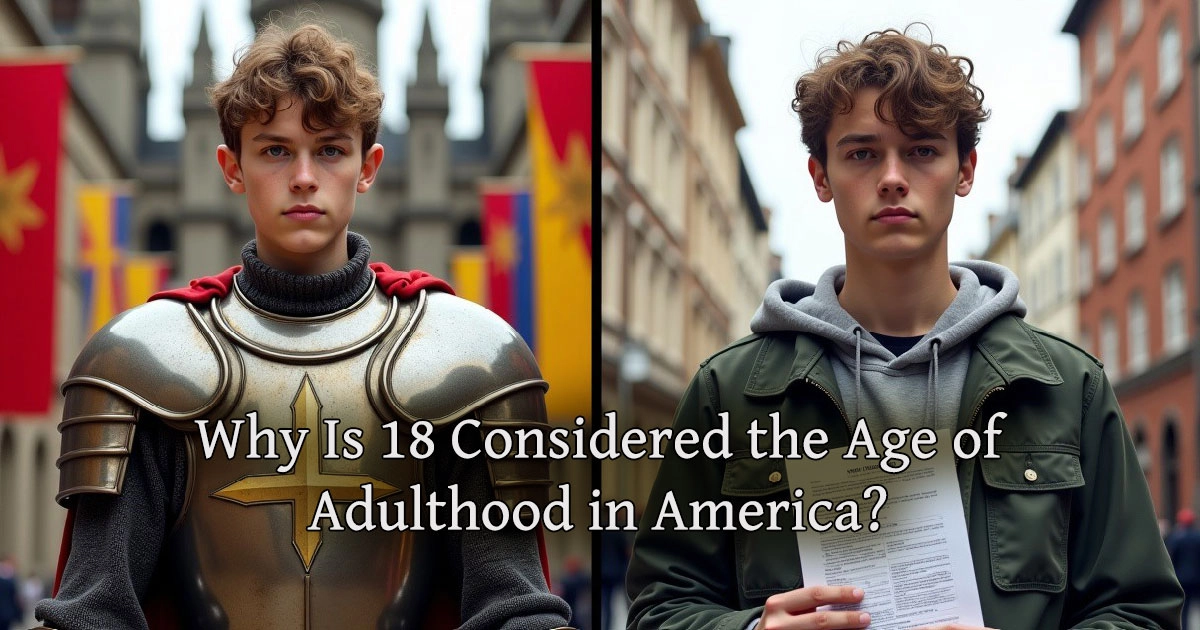

If you live in the U.S., you probably take it for granted that 18 is the age when you officially become an adult. It’s when you can vote, sign contracts, join the military, and move out without anyone’s permission. But why 18? Why not 16? Why not 21?
As it turns out, 18 wasn’t always the standard. In fact, for most of history, 21 was the real age of adulthood. This was a tradition that dated back to medieval knights, landowning nobles, and, ultimately, the brutal realities of war.
So, how did 18 take over? Let’s go back in time.
Hundreds of years ago, if you were born into nobility, your path in life was largely decided for you. And for young boys with aspirations of knighthood, the journey was clear:
But knighthood wasn’t just about swinging swords. 21 was the age when noblemen could inherit land, handle legal matters, and take full control of their lives.
This idea of 21 as the threshold of adulthood stuck around for centuries. English Common Law, which influenced American legal traditions, adopted 21 as the age when a person could independently own property, enter contracts, and be legally responsible for themselves.
And for most of history, that was the rule.
So, how did we end up with 18?
Fast-forward to the early 20th century. The world is at war, and governments need soldiers... a lot of them.
Before WWI, 21 was the standard age for military drafts, just as it was for most legal responsibilities. As casualties mounted and armies needed reinforcements, governments, including the United States, reduced the draft age to 18.
For the first time, 18-year-olds were being sent to war, expected to fight and die… yet they still weren’t considered full adults under the law.
That contradiction would only grow stronger in the next war.
By WWII, the draft age was once again 18, and this time, there was no going back.
Millions of teenagers were being handed rifles and told to fight. And yet, when they came home, they still couldn’t vote, sign contracts, or be recognized as legal adults.
The question became unavoidable: If you’re old enough to die for your country, shouldn’t you be old enough to be an adult?
This debate would simmer for decades, until the next big war made it impossible to ignore.
By the 1960s, the U.S. was fighting in Vietnam, and once again, 18-year-olds were being drafted in huge numbers.
And once again, they couldn’t vote.
The voting age was still 21, just like it had been for centuries. That meant an entire generation of young men were once again, being sent to war without any say in the leaders sending them there.
And people weren’t happy about it.
Protests erupted. The slogan “Old enough to fight, old enough to vote!” became a rallying cry. The pressure was immense.
And in 1971, the U.S. finally caved.
The 26th Amendment was passed, officially lowering the voting age from 21 to 18.
At that moment, 18 became the new standard for adulthood.
And because voting was such a fundamental right, other laws soon followed—signing contracts, getting married, serving on juries, and other adult responsibilities all shifted to 18 as well.
Even though 18 became the legal age of adulthood, some laws still held onto the old 21 standard—most notably:
In other words, traces of the old 21 rule never fully disappeared.
Not because of science. Not because of tradition. But because of war.
For centuries, 21 was the age of responsibility, passed down from medieval knights to landowning nobles and into early American law. But when the World Wars and Vietnam forced 18-year-olds into battle, the law had no choice but to catch up.
The U.S. couldn’t justify sending teenagers to die while calling them “kids.” And so, in 1971, adulthood officially became 18.
So the next time you wonder why you could join the military before you could legally drink a beer, remember; you’re still living in the legacy of knights, war drafts, and a fight for fairness that changed history.